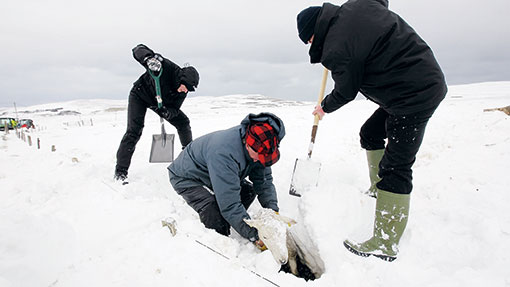Livestock farms fight back after 2013 snowstorms

A year ago, freak snowstorms paralysed livestock farms in the UK in the worst spring blizzards in 50 years. Debbie James reports on their road to recovery.
The financial and emotional scars are fading but are yet to heal completely on livestock farms that bore the full brunt of last spring’s harsh weather.
Heavy snowfall crippled hill farmers and decimated feed supplies, resulting in large numbers of dead sheep and cattle .
Welsh farmer Haf Morris’ voice still chokes with emotion when she recalls how dozens of lambs perished when ewes aborted or were too weak to feed their offspring.
It took months for the business to get back on its feet, and if it hadn’t been for the family’s small self-catering diversification, they would have struggled.
Fewer lambs to sell
The farm has survived but the financial loss is high because there were fewer lambs to sell.
“We had 60% less lambs from the Welsh sheep and 20% fewer Mule lambs,” said Mrs Morris, who farms with her husband, Dai, and two sons, Elwyn and Dafydd, at Maes Farm in the Berwyn Mountains in north-east Wales.
The business has sustained the financial loss but the crisis has focused the family on the future and implications of reduced support payments.
From 2015, the business will receive just €20/ha (£16.58/ha). She feels the decision to award support payments of between €200/ha (£166/ha) and €250/ha (£207/ha) to farms at a height of under 400m above sea level is unjust.
“We are now facing more financial loss. It is a great worry to me,” she said.
“My husband is 66 and I’m 63. We would not have been able to cope last spring without our two sons. But how can the next generation be expected to farm these hills with so little support?”
Isle of Man hit hard
One of the worst-affected regions was the Isle of Man, where 16,000 head of livestock died between 22 March and 3 May last year, compared to 11,052 for the whole of 2012.
Manx suckler producer Stuart Howard lost 30 cows and calves. He questions how the business would have survived without government aid and the Isle of Man Agricultural Benevolent Trust.
“That support meant we were able to replace the cattle we lost,” he says.
Heather Moore also farms on the island, with her partner Robbie Christian. They lost 45% of their breeding ewes and lamb sales took a big hit.
“We would normally have sold between 500 and 600 lambs but we sold 180,” she said.
If they had not paid off the farm mortgage, it is unlikely they would still be in business, she added. “We saw 10 years of work disappear within 12 hours. We are hanging on by the skin of our teeth but it will take years to get back to where we were.’’
The events of last spring have left an indelible psychological scar, not just on the couple but on their six-year-old twins. “We had a flurry of snow recently and they got really upset because they didn’t want all the sheep to die,” she said.
Pulling dead animals from the snow
Welsh hill farmer Gareth Wyn Jones vividly recalls digging hundreds of dead sheep and ponies out from the snow on his Conwy farm but his business has now recovered.
He recently featured in a BBC Wales series The Hill Farmer, recording the highs and lows of life as a Welsh farmer .
Mr Wyn Jones said last spring’s catastrophe has given him a new perspective on life. “It has changed me as a person. I live life each day as it comes and I see that as a massive positive,” he insisted.
Elsewhere in Wales, Powys lamb producer Rhys Roberts has felt the repercussions of last spring in his flock’s poor prolificacy this season.
The flock would usually scan at 130%; this year’s scanning percentage of 110% is his lowest ever. But he is philosophical and draws a positive from the situation. “I have less lambs a ewe but the lambs are bigger and stronger,” he said.
In Cumbria, time has been a great healer for Herdwick producer Eric Taylforth.
Last year he had struggled to feed his flock after lambing but 12 months on and he is upbeat.
“Last spring was terrible but you soon forget. Sheep prices are now good, we produced good-quality feed last summer and we couldn’t have wished for better weather than we are experiencing this week.”
Scale of lamb losses by region
Sheep loss figures published by the National Fallen Livestock Company are a startling reminder of last spring’s harsh conditions.
In England, lamb numbers took a hit with the loss of approximately 30,000 more lambs in April and May 2013 compared with the same period in 2012.
For Scotland, ewe and lamb numbers were both badly affected during that period, with about 55,000 ewes perishing compared to approximately 20,000 12 months earlier. About 40,000 more lambs died.
In Wales, lamb losses climbed from under 80,000 to nearly 120,000, while in Northern Ireland lamb mortalities rose from 6,000 to 10,000.
